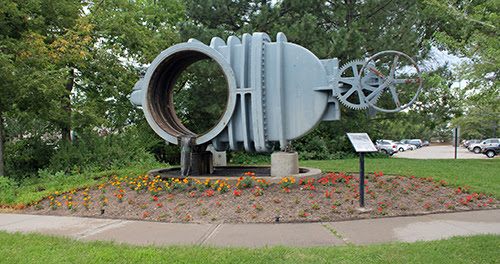I see that Boxer helped himself to my newsletter last month. Don’t tell him I said this, but I was hoping he’d do that.  Maybe I’ll leave my laptop unattended for him again some other month.
Maybe I’ll leave my laptop unattended for him again some other month.
Gaming update: I’ve made many more art improvements to the game and am almost done changing all of Mallory’s animations from skeletal to flipbook style. This will make her movements smoother and more natural. I’ve also started creating the Imnan and Daishonic languages. I’ll probably devote a few newsletter articles to that when those are further along. If you haven’t already, play the Scribes’ Descent sample here: https://dylanwestauthor.com/demo
Waterflows in the Bioprison
In Scribes’ Descent, there are three main cities in the deep mine known as the Bioprison. Paito sits about a half kilometer above Faisis and Faisis sits about a half kilometer above Sendia, with a vertical shaft running between each city. And like Mallory realizes in the first chapter of Scribes Aflame, an aquifer outside of the Bioprison supplies freshwater to these cities through a tunnel called The Source.
In Paito, that water flows down to the top of an underground mountain, where aqueducts channel some of it sideways into farms. The rest of the water spills freely down the mountainside and into straight vertical shafts that run down to the various cities of the Triurn–a region that is mainly flat plains but slightly slanted southward. Faisis is the biggest city there, and has a reservoir to dam up water before it flows down to Sendia.
Why a reservoir?
Over one million people live in Faisis and its neighboring cities, so they need much more water than Paito does, which has only around 50,000 people. Faisis has enormous farms and can’t afford to let too much water slip past. The Triurn also needs a high water level in its rivers for its many cargo ships. That’s why their engineers dug a lake at the bottom of the Triurn right before it drains to Sendia and built a dam with a massive gate valve in its outlet. Operators open and close the gate valve to control drain flow.
But why control flow? Remember that this water comes from an aquifer outside the Bioprison. Its water level rises during heavy rains and falls during droughts. This has profound impacts on the Bioprison. If reservoir operators don’t open the gate valve all the way during heavy rains, Faisis may get flooded. And if operators don’t shut the gate valve during droughts, the reservoir will run dry. An empty reservoir would:
-ground ships and disrupt trade between cities
-kill fish and upset the fragile food web of the Triurn
-drain their biggest backup source of water (separate irrigation canals upstream of the reservoir divert water onto farms and into the city’s water treatment plant, making those the primary water source)
Reservoir Construction
What sort of gate valves are we talking about? The chonky kind:
 |
Valves this big must be motor-operated. Someone sits at a control panel, watches flowrate and water level gauges, and turns a switch to open or shut the valve accordingly. As advanced as Faisis is, it lacks the computerization needed to electronically monitor and control these valves without human intervention.
Now you may wonder why they didn’t just opt for a shaft spillway design. (I know you were all thinking that!) In this design, a hollow vertical shaft stands inside the reservoir with an open funnel at the top:
 |
When level rises above that point, water flows over the funnel and into an outlet tunnel running under the dam where it drains into the downstream river. No big valves and motors needed. If keeping a set water level in the reservoir were the only concern, this would be perfect.
But when flowrate is low for too long, keeping a steady water level would deprive the downstream river (and Sendia) of water. So during droughts, Faisis lets the reservoir level drop slowly in hopes that flowrate will soon pick up again. Only a few droughts were so severe that the Triurn had to rely exclusively on their freight trains to move goods. So in 300 years, this system has worked well. At least until Scribes Aflame, that is. Try the free sample of book two to see what I mean: https://dylanwestauthor.com/scribes-aflame/
To learn more about controlling water flow out from dams and reservoirs, read this article: https://britishdams.org/about-dams/dam-information/spillways-and-outlets/ and watch the hydraulics videos on Practical Engineering: https://www.youtube.com/watch?v=5mCJh5SJEis&list=PLTZM4MrZKfW_XJht-K7a9_egIsFqze0nQ&index=27
I could go into SO much more detail about this reservoir’s design: how it was constructed, what remnants of that construction still linger, how the gate valve is inspected and replaced, how flowrates are measured, what accidents this structure has suffered over the centuries, why nobody has converted it into a hydroelectric power plant, why they opted for a gate valve instead of overflow and side channel spillways, how do they control erosion, and so on… But those can wait for another newsletter. Have any questions you want answered now? Reply to this email and let me know.
Writing update: Scribes Emerge is the next book in the Scribes Series, and I should begin revising it sometime next month. First, I want to knock out a few more improvements to Scribes’ Descent, the game. Also, as of Oct 27th, I sold over 1,000 copies of Scribes’ Descent! I set out to reach this sales goal within 2 years, but reached it in 1.5  Thanks to all who’ve bought, read, and reviewed my books!
Thanks to all who’ve bought, read, and reviewed my books!
See you next month
